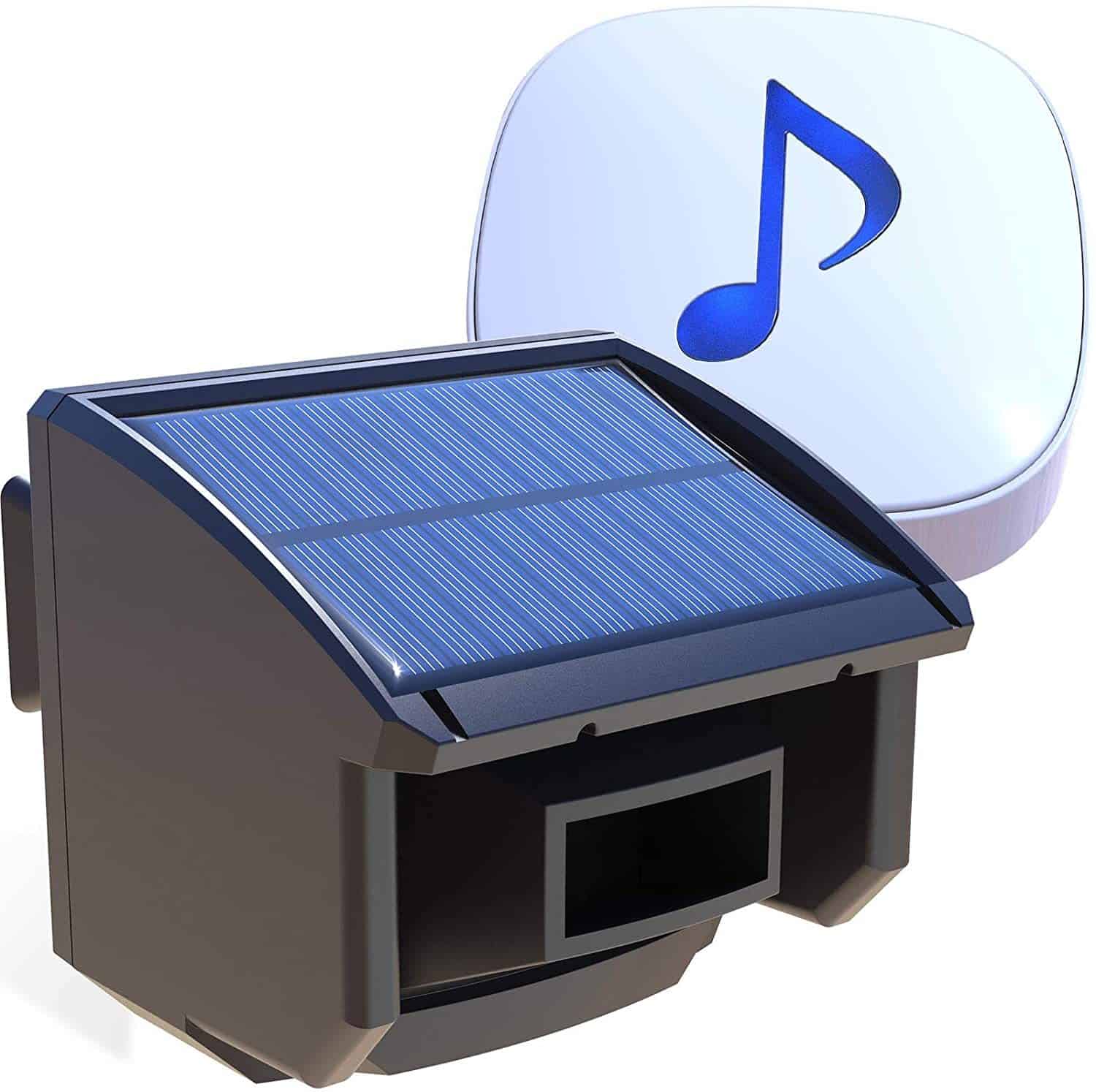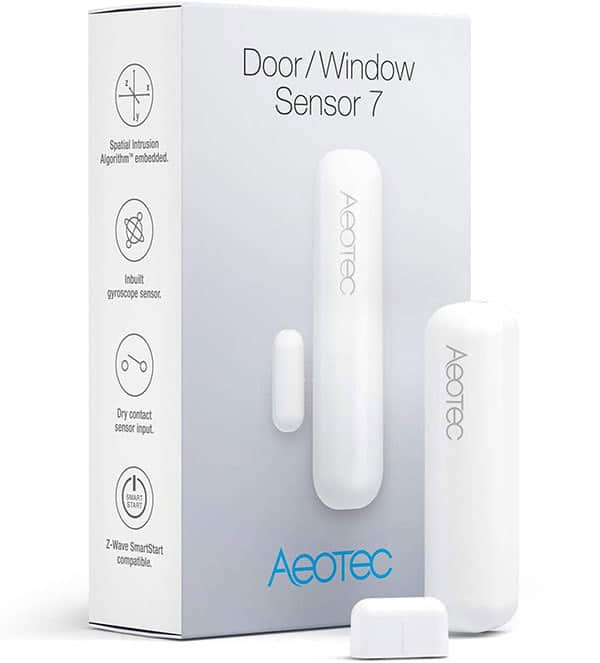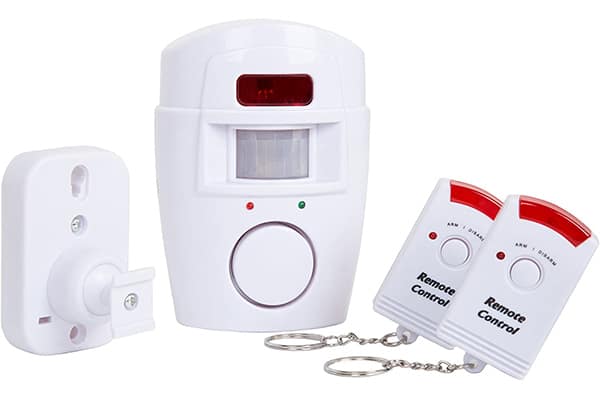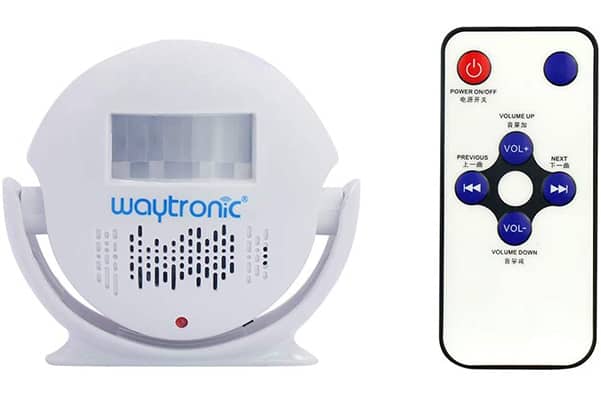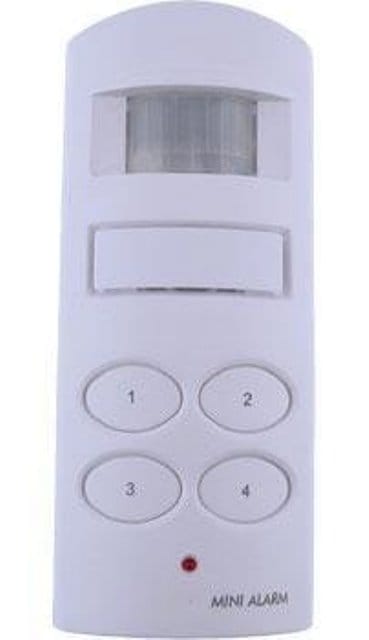The 7 Best Shed Alarm Systems for Under $100

There are 3 decisions to make about shed alarms and keeping intruders out of your shed
Quick Navigation
THERE IS ONLY so much you can do to secure your shed and make it virtually impossible for someone to break into and steal your gear.
After installing new locks, securing the windows, and creating a virtual fortress, the only thing left is to install a shed alarm system that lets you know when someone is trying to break in. According to research, clearly visual alarms reduce the chance of break in and deter burglars.
There are typically 3 decisions you need to make before you can get a shed security system...
Here we take a look at what you should be searching for in an alarm system and then at seven of the most popular alarm systems on the market.
Decision 1: The 3 Types of Security System Monitoring
There are a number of different factors you need to consider when it comes time for you to purchase a shed alarm as the final piece in your shed security plan.
With so many different types of alarm systems on the market, making the right choice can easily become overwhelming.
Here we are going to go over some of the most important issues you need to consider before shelling out your hard earned cash for a shed alarm.
1. Monitored Home Security
One of the fastest growing forms of home security in the U.S. is monitored security. With this type of security, you sign a contract with a company like ADT who then come to your home and install a complete home security system.
The company then comes to your home and installs a wide range of security equipment including sensors, sometimes cameras, and keypads.
While most don’t charge you for the system, they do obligate you a contract that provides you with 24/7 monitoring for a fee. Although the monthly rates vary from company to company, most are under $50 for basic monitoring services.
We monitored home security here because you can put one of these house monitors in your shed, and use it through the keypad in your home.
2. Wireless Monitoring
With this type of shed security, you can either install a system yourself or have one professionally installed.
Any time one or more of the sensors is tripped by a burglar, you are immediately notified via your cell phone. Some systems will also notify your local police department so they can send someone to investigate.
Many do-it-yourself versions of this type of alarm can be found for under $100, however, if you want more than the most basic of features, you may have to pay more.
3. Siren Notification
Shed alarms with siren notification are pretty much exactly what they sound like. You install door and window switches, and motion sensors in your shed.
Some have a key fob to enable/disable them others use a keypad. Any time someone enters your shed when they are not supposed to be there sets off the alarm which then sounds an incredibly loud siren.
These are only effective when someone is home and may annoy your neighbors if for some reason they keep going off.
How to Know which Monitoring Method is Best for your Shed, House or Garage
As we stated above you have a range of options when choosing your shed alarm regarding how it is monitored. If you go with a professionally installed and monitored system, your shed and in most cases your entire house will be covered by a range of sensors and cameras.
The monitoring is done by a team of trained security specialists whose job it is to monitor hundreds of homes at the same time. Should the alarm in your home or shed go off, they will notify the police and contact you.
This type of monitored security has a number of advantages, not the least of which is virtually instantaneous notification of both you and the police that someone is breaking into your shed.
This means the police will be on their way as quickly as possible. Monitoring companies also provide signage that lets everyone know that your house is monitored, this frequently deters thieves who would rather go somewhere that isn’t protected.
With a cell phone monitored system, you will receive a notification on your phone that the alarm has been triggered. This gives you the opportunity to contact the local police or determine that the alarm has gone off in error.
While it may take a little longer to notify the police, these systems can reduce the number of false callouts, which should make your local police happier.
They are also a one-time expenditure with no monthly fees other than your cell phone service. Unless you plan to install a complete home alarm system, this type of alarm might be the best choice for you
Decision 2: What Type of Monitoring and Detection Will Suit You Best?
Next on the list of things to consider as you shop for your shed alarm is what type of monitoring and detection you plan to use. There are several options including different types of switches, sensors, and cameras to choose from.
While each of them is capable of doing the job of protecting your shed to a certain degree, your best bet may be to use a combination of them for maximum security.
Switches
These simple magnetic devices can be attached to doors and windows. They come in two parts, on one side is the switch itself, on the other a simple magnet.
When the door or window is closed the switch is held in an open or closed position. Once the door/window is opened, the contacts in the switch open or close and the alarm is triggered.
You should plan to have at least one switch on every window and door in your shed. Most modern systems use wireless switches for ease of installation.
Sensors
This section is subdivided into motion and infrared or thermal sensors. Here again, you should plan to have at least one of each in your shed alarm system.
Depending on where you can locate these sensors, between the two of them your entire shed can be covered. This way if anyone manages to sneak into your shed, one or the other of these sensors will pick them up and sound the alarm.
Cameras
Here again, you have a choice between normal imaging cameras, infrared cameras, or those that can do both.
Adding one or more security cameras can help you keep a close eye on your shed and record anyone who goes near or in it, depending on where you place the cameras.
However, adding one or more cameras can add to the cost of your shed alarm system. Only you can decide whether or not the added expense is worth it.
Bear in mind you can use any recorded footage to help identify and prosecute the thief is they are caught.
Few Important Points About Choosing Your Shed Alarm
Before you get too carried away looking the many different types of monitored and do-it-yourself shed alarms, you need to consider whether you are a renter or a homeowner.
If you are a renter, you should be looking for an alarm system you can install yourself and remove if and when the time comes to move.
There are a few companies that offer monitored alarms for renters, but you should check with your landlord before installing any type of alarm system.
When you own your home, you have the advantage of being able to install virtually any type of alarm system you desire.
Decision 3 - The Shed Alarm Itself... 7 Shed Alarms for Under $100
1. GE Choice Alert Wireless Alarm System
Fast, Easy to Install Basic Alarm Kit
This starter kit contains just about everything you need to put an alarm system in your shed or garage. In the kit is a multifunctional control center and a single wireless sensor that can be attached to the door or a window.
You can add up to 16 sensors to the system, allowing you to add motion sensors, door/window sensors, and water leak sensors.
It features a wireless keypad, a key fob remote, and a panic button. The Choice Alert is designed for easy do-it-yourself installation so that virtually anyone can install it.
pros | cons |
|---|---|
Easy to Install: since there is no wiring required, you attach the sensor and turn on the control panel. | Limited range: Depending on what your shed is built out of, it may have a very limited range. |
Expandable: There are 16 channels you can use to connect a range of sensors. | Kit only includes one door/window sensor: While it can handle up to 16 sensors, you only get one, if you want more you have to buy them separately. |
No wiring required: Many older systems required you to run wires between the sensors and base station/control panel. | Can be tricky to program initially: The programming instructions are hard to follow unless you are technically savvy. |
2. GE Wireless Security Surveillance Alarm
Very Basic Alarm that Performs Flawlessly
This is a motion sensor style alarm that is ideal for use to protect your shed. The built-in PIR sensor will pick up any movement inside of your shed and sound an audible alarm.
The alarm is more than loud enough to be heard in your house, even with the windows closed. In the package is the base unit/motion sensor/alarm and a wall mount plate.
You also get a pair of keychain style remotes that let you turn on the alarm from the inside of your house. The only thing you need to provide is four AA batteries.
pros | cons |
|---|---|
Easy Installation: Wireless design, the wall mount plate requires two screws to hang the sensor/alarm/control unit. It can be hung virtually anywhere as long as it covers the inside of your shed | Non-expandable: This is a motion sensor alarm, nothing more, you cannot add door/window sensors. |
Battery power: Your shed will be protected, even when if the power goes out. | Battery power: While being able to remain protected if the power goes out is nice, if the batteries die you are not protected. |
Loud: The alarm sounds a 105 dB siren that most people can hear in their house and is sure to scare burglars away | On/Off only remotes: The remotes do not notify you if the alarm has been tripped. |
3. Htzsafe Outdoor Solar Power Alarm System
Solar Power with an Outdoor Strobe and Siren
Solar power charges the internal batteries of this alarm system so you never have to worry about plugging it in or running out of juice.
The single sensor is pre-linked at the factory so set up is a breeze. All you have to do is mount the outdoor unit on a spot of your shed where it will get plenty of sunshine and install the single included door sensor.
The alarm unit is expandable and can handle up to 99 sensors. Kit includes a single key fob remote that is used to turn the alarm on or off.
pros | cons |
|---|---|
Extremely Easy to install: Simply mount the alarm to a convenient outside wall and the included sensor to the door and door frame. | Does not come with multiple sensors, you get a single door sensor. If you want a motion sensor or more standard sensors you have to buy them. |
Long-life battery: The internal battery will last up to a month once fully charged. | It will take a full month to fully charge the battery when you first install the alarm. |
Tamper proof case sounds the 120 dB alarm if anyone attempts to tamper with it. | Installation instructions: They are not easy for a novice to fully understand. |
4. Aeotec Z-Wave Plus Door/Window Sensor
Low Cost Effective Security for your Shed
You can use this simple wireless alarm to protect your shed door or window. Everything you need except the mounting screws is included in the package.
The wireless magnetic switch can be installed on a door or a window. The alarm will sound anytime the door or window is opened.
This may be one of the simplest shed alarms on the market. It is battery powered and has a low battery indicator to ensure your alarm will always be ready when you need it.
Can be incorporated into the STI Burglar Stopper Wire-Free Home Protection System designed to protect your whole house.
pros | cons |
|---|---|
Super easy installation, simply screw the door sensor in place, add batteries and you are ready to go. | Simple alarm unit chimes when the door is opened but is not very loud |
Alarm unit chimes anytime the door is opened. | Has a limited range. |
Can be added to the whole house system by STI | The base unit is not expandable. |
5. Everyday Home Wireless Infrared Sensor Alarm With Two Remotes
Simple Infrared Passive Motion Sensing Alarm
With this system, there are no door or window sensors to install. Instead, you mount the IR sensor on the wall at a height of 1.5 to 2.0 m from the floor, install the batteries and you are ready to go.
Any time someone enters your shed who is not supposed to be there, the alarm sounds. The alarm is exceptionally loud at 105 dB which is loud enough to be heard inside the house and will wake most people.
The alarm will sound for 30 seconds before resetting. Unit comes with a pair of remote controls and a mounting bracket.
PROS | CONS |
|---|---|
Very Affordable IR motion sensor protection. Works as well as many more expensive units | If you let the batteries die your shed will be without security protection. |
Good Range: Can detect motion in an 110-degree swath when properly mounted and reach out as far as 4 meters. | Kit does not come with mounting screws, might not seem to be a big deal until you find you don't have any screws. |
Battery powered: Will keep working even when the lights go out. | The alarm could be louder as 105 dB may not scare a thief away. |
6. L6D-NEW 360° Ceiling Motion Sensor
A New Take On Motion Sensor Alarms
This unit is designed to be mounted on the ceiling of your shed. The infra-red sensor then detects any motion in your shed and sounds the alarm.
Comes complete with a single key fob remote that features a panic button. The unit is battery powered but you can buy an optional AC adaptor.
The unit covers a 360-degree pattern to fully protect your shed or garage. While the alarm has a built in alarm, you can also purchase an outdoor siren kit for added security.
Pros | cons |
|---|---|
Simple Installation: It takes two screws to mount the alarm to the ceiling of your shed. | Since the entire unit is located inside your shed, you may or may not be able to hear it if you are in the house. |
Loud: The built-in siren is rated at 105 dB, which is standard for most interior alarms. | You have to buy an outside siren unit for an additional fee if you want to ensure you can hear the alarm when it goes off. |
Offers you very affordable protection for your shed. | Battery power is ok, but if you want to use AC power you have to buy a power supply. |
7. UniquExceptional UMA20 Motion Alarm
Single Unit Simple to Use Shed Alarm
This may be the simplest shed alarm yet. The entire alarm system is contained in a single unit that can be mounted on any wall in your shed.
It offers a super loud 130 dB alarm and can be turned on and off by entering a code on the keypad. You can easily program your own code for added security.
Battery powered, but again you can also buy a separate AC adaptor. You can also buy an external siren and connect it directly to the built-in port. Covers an area that is 60 degrees wide by 20 feet long.
PROS | CONS |
|---|---|
Very affordable: As a single unit this is one of the most affordable units that works as described. | Lower cost does cut down on coverage area, which may or may not be a good thing depending on the size of your shed. |
Has a port to add an external siren: This is a good thing as you may not be able to hear the siren from inside your home. | Battery power is ok, but can be a problem if the batteries die, leaving your shed unprotected. |
Programmable security code: By programming your own code and changing it on a regular basis you improve the unit's effectiveness. | You have to buy the AC adaptor or live with the risk of dead batteries. |
In Conclusion
These are only a sampling of the simplest DIY shed alarm systems, each is capable of offering protection from would-be thieves.
My Preference
While they all have their good and bad points, the ERAY Outdoor Solar Power Siren Alarm comes out the winner.
It offers full solar power with a battery backup and can be expanded to handle a range of different sensors to ensure your shed is fully protected at all times.
The only thing it cannot do is be connected to a camera or call the police for you. If you want features such as these, they are going to cost you more than $100, but in reality are probably not worth the extra cost.
Read Some More
If you already have a shed set up - or thinking of building or buying one - you should consider security measures to keep your belongings safe.
Thanks for taking the time to read this.
If you have any other ideas, feel free to let us know. Contact me here.
Like what you have just read, share this information with your friends on Facebook, Pinterest, Twitter.
Related Articles:



